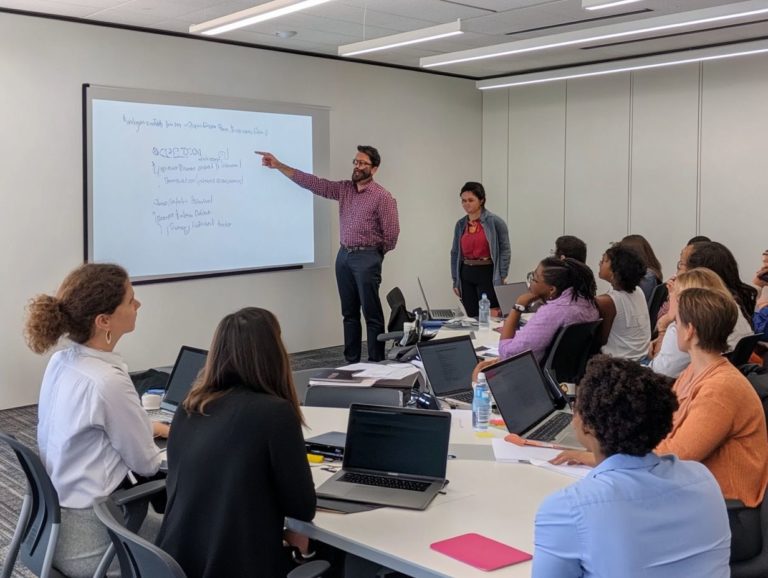What Are the Best Practices for Corporate Training?
In today s fast-paced business environment, corporate training has emerged as a vital necessity for both employees and organizations alike. Get ready to discover best practices that can elevate your corporate training initiatives to new heights.
This article delves into the many benefits of effective training, guiding you through the process of identifying specific training needs and designing impactful programs. It explores various delivery methods that engage participants and examines strategies to evaluate the effectiveness of your training initiatives.
You ll also discover the critical importance of continuous improvement to adapt to ever-evolving needs and technologies.
Contents
- Key Takeaways:
- The Importance of Corporate Training
- Identifying Training Needs
- Designing an Effective Training Program
- Delivering Training: Methods and Techniques
- Evaluating Training Effectiveness
- Continuous Improvement in Corporate Training
- Frequently Asked Questions
- How can you make corporate training effective?
- How can I identify the training objectives for my company’s corporate training program?
- What are some effective training methods and formats for corporate training?
- How can I engage employees in the corporate training process?
- Should corporate training be a one-time event or an ongoing process?
- How can I measure the effectiveness of my company’s corporate training program?
Key Takeaways:

- Identify specific training needs to create a tailored program that caters to the unique needs of employees and the organization.
- Choose suitable delivery methods and techniques that engage and motivate participants to maximize the impact of corporate training.
- Evaluate success by measuring learning outcomes and continuously adapt to changing needs for improvement in corporate training.
The Importance of Corporate Training
Corporate training stands as a vital pillar for both employees and organizations. It sharpens individual skills, expands knowledge, and cultivates a thriving workplace culture while fueling organizational growth.
By investing in tailored employee training programs, you can pinpoint specific development opportunities that address diverse learning needs. Effective training also boosts employee engagement and satisfaction, setting the stage for ongoing learning.
Benefits for Employees and Organizations
Corporate training offers numerous benefits for both you and your organization. It significantly enhances employee engagement, satisfaction, and overall performance.
This development fosters a sense of accomplishment and loyalty among your team. It also aids in skill retention, ensuring that everyone is prepared to tackle their responsibilities.
For your organization, enhanced performance leads to increased productivity and improved employee retention rates. This creates a dynamic work environment that encourages innovation.
A well-trained workforce adapts more seamlessly to changes in the market or technology, helping your organization maintain a competitive edge.
Ultimately, these elements create a more cohesive and motivated team, benefiting everyone involved.
Identifying Training Needs
Identifying training needs is essential for optimizing corporate training programs. By conducting a thorough training needs assessment, you can effectively address specific learning requirements and skill gaps among employees.
This approach enhances training relevance. It ensures your organization invests in meaningful development.
Conducting a Training Needs Assessment
Conducting a training needs assessment requires using various methods, including employee surveys and feedback mechanisms, to identify areas that need skill development accurately.
This process is crucial for organizations intent on enhancing workforce capabilities and overall performance. By implementing diverse assessment techniques like one-on-one interviews, focus groups, and direct observation, you gain a thorough understanding of existing gaps.
Employee surveys provide anonymous feedback that reveals specific challenges in the workplace. Combined with constructive feedback, these approaches help align training initiatives with genuine employee needs, ensuring effective resource allocation.
Dedicating time to these assessments boosts morale and fosters a culture of improvement in your organization.
Consider implementing what you ve learned to enhance your corporate training initiatives.
Designing an Effective Training Program

Crafting an effective training program is crucial for achieving organizational goals while providing employees with personalized learning experiences tailored to their unique needs.
Key Components of a Successful Program
A successful training program incorporates a range of innovative methods, such as gamification, collaborative learning, and experiential learning. For more insights on how these methods are applied, you can check what to expect from a corporate training session. These approaches foster continuous growth among employees.
These methodologies cater to various learning styles and actively engage participants, enhancing knowledge retention. Gamification adds game-like elements to learning, making it enjoyable while igniting a competitive spirit. Collaborative learning emphasizes teamwork and peer support, enabling individuals to share insights and broaden their perspectives. Experiential learning immerses learners in real-world scenarios, sharpening practical skills and critical thinking.
By weaving these approaches together, organizations cultivate a dynamic environment that elevates employee performance and nurtures a culture of lifelong learning.
Delivering Training: Methods and Techniques
The effective delivery of training is essential for maximizing engagement and learning retention. You have various methods at your disposal, including synchronous and asynchronous training, along with innovative options such as virtual reality experiences and peer-to-peer feedback.
Embracing these diverse approaches can significantly enhance the learning journey.
Choosing the Right Delivery Method
Pick the right delivery method to boost your team s learning experience! Choosing the right delivery method is vital for addressing diverse learning preferences and enhancing knowledge retention.
You have a range of training delivery methods available, including face-to-face sessions, online courses, blended learning, and self-paced modules. Each has its unique benefits and challenges.
In-person training allows for immediate feedback and fosters interpersonal engagement, making it perfect for hands-on learners. However, it can come with logistical complexities. Conversely, online courses provide flexibility, allowing individuals to learn at their own pace a great option for those juggling busy schedules. However, they may lack the personal touch some learners crave for motivation.
Blended learning emerges as a balanced solution, combining the strengths of both formats to effectively cater to various preferences.
Engaging and Motivating Participants
Engaging and motivating participants in training programs is essential for maximizing employee engagement and enhancing overall training effectiveness.
To achieve this, consider incorporating strategies like gamification and establishing feedback loops. Gamification adds excitement, fostering healthy competition among participants and inspiring active engagement. Feedback loops provide ongoing assessments that encourage immediate reflection and improvement, helping learners recognize their progress and identify areas needing attention.
By seamlessly integrating these techniques, you can cultivate a more interactive and stimulating learning environment, ultimately leading to improved retention and practical application of knowledge.
Evaluating Training Effectiveness

Evaluating the effectiveness of training is crucial for understanding how training programs influence employee performance and for ensuring that learning objectives are successfully achieved.
By assessing this impact, you can refine your approach and enhance the overall quality of your training initiatives.
Measuring Learning Outcomes and Impact
Measuring learning outcomes and their impact is crucial for assessing the effectiveness of your training programs and understanding how well employees retain knowledge.
You can employ various approaches to achieve this, including formative and summative assessments that evaluate understanding both during and after training sessions. Utilizing feedback mechanisms like surveys and performance reviews gives you a more comprehensive view of the learning experience.
These evaluations not only spotlight areas for improvement but also assist in refining instructional methods to better align with your organizational goals.
By analyzing these metrics, you can effectively pinpoint gaps in knowledge and comprehension, ultimately leading to enhanced performance and a greater return on investment in your training initiatives.
Continuous Improvement in Corporate Training
Continuous improvement in corporate training is essential for your success in adapting to evolving needs, technologies, and best practices for virtual training in employee development.
By embracing this approach, you position your organization to thrive in a dynamic landscape, ensuring your workforce remains engaged and equipped with the skills necessary for success.
Adapting to Changing Needs and Technologies
Adapting to the ever-changing landscape of needs and technologies is essential for ensuring that your corporate training programs remain relevant and effective in meeting employee learning requirements. Understanding the types of corporate training programs can help in this endeavor.
By embracing innovative digital tools and methodologies, you can significantly enhance engagement and create personalized learning experiences.
It’s vital to create a culture of ongoing improvement by regularly assessing training outcomes and seeking feedback from employees. This proactive approach aligns your training initiatives with the evolving demands of the workplace and enables individuals to develop skills that can elevate their career trajectories.
Implementing learning management systems tools that help organize and manage training and offering flexible training formats are key strategies that can keep your organization competitive and responsive to the dynamics of the workforce.
Frequently Asked Questions
How can you make corporate training effective?

The best practices for corporate training vary depending on the specific needs and goals of the company. To ensure effectiveness, it’s important to understand what makes a successful corporate training program. Key practices include:
- Identifying training objectives
- Utilizing different training methods and formats
- Engaging employees in the learning process
- Providing ongoing support and feedback
- Evaluating the effectiveness of the training program
How can I identify the training objectives for my company’s corporate training program?
To identify training objectives, it’s important to first understand the overall goals and needs of the company. This can be done through surveys, interviews, and discussions with key stakeholders. From there, specific learning objectives can be established that align with the company’s goals and address any identified skill gaps or areas for improvement.
What are some effective training methods and formats for corporate training?
Many different training methods and formats can be effective for corporate training, including in-person workshops, online courses, on-the-job training, and mentorship programs. Understanding common challenges in corporate training is important when choosing the methods and formats that best suit the needs and learning styles of your employees.
How can I engage employees in the corporate training process?
Engaging employees in the training process is crucial for the success of any corporate training program. Understanding the future of corporate training can help in achieving this by:
- Creating interactive and relevant training materials
- Incorporating real-life examples and scenarios
- Allowing for opportunities for discussion and feedback
It’s also important to communicate the benefits of the training and how it aligns with the company’s goals.
Should corporate training be a one-time event or an ongoing process?
Corporate training should be an ongoing process rather than a one-time event. Understanding the purpose of corporate training is crucial for employees to stay ahead and adapt to changes in the workplace. Ongoing training shows that the company values employee growth and encourages a culture of learning.
How can I measure the effectiveness of my company’s corporate training program?
To measure a corporate training program’s effectiveness, set clear goals. This helps collect data and feedback to evaluate the training’s impact on employee performance and company success, including understanding the legal requirements for corporate training.
Surveys, assessments, and tracking key metrics can be a game-changer in understanding your training’s effectiveness!






